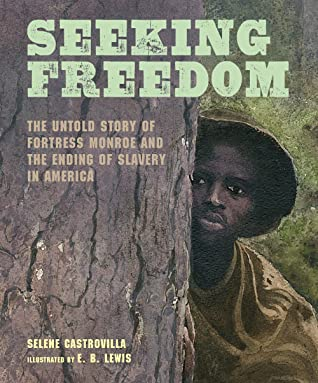"Seeking Freedom" and "Evicted" are two powerful nonfiction picture books for older readers!
ABOUT THE BOOK
In this dramatic Civil War story, a courageous enslaved fugitive teams with a cunning Union general to save a Union fort from the Confederates–and triggers the end of slavery in the United States. This is the first children’s nonfiction book about a Black unsung hero who remains relevant today and to the Black Lives Matter movement.
On the night Virginia secedes from the Union, three enslaved men approach Fortress Monroe. Knowing that Virginia’s secession meant they would be separated from their families and sent farther south to work for the Confederacy, the men decided to plead for sanctuary. And they were in luck.
The fort’s commander, Benjamin Butler, retained them—and many more that followed—by calling them “contraband of war.” Butler depended on the contrabands to provide information about the Confederates. He found the perfect partner in George Scott, one of the contrabands, whose heroism saved the fort from enemy hands. And, it was the plight of the contrabands that convinced President Lincoln that slavery MUST be abolished and inspired him to write his Emancipation Proclamation, ending slavery in the rebellious states.
REVIEW
This stunning nonfiction picture book tells the story of the beginning of the end of slavery. In a lesser known series of historical events, a man named George Scott entered Fort Monroe with other black fugitives in the hope of receiving refuge from slavery. Major General Benjamin Butler chose not to return the fugitives to their enslavers, he claimed them as "contraband of war". With George Scott's help, General Butler and his troops marched out to capture or destroy the Confederates hiding nearby. Despite an ambush and great loss of life, the Confederate threat to Fort Monroe was ended. General Butler sent a letter to President Lincoln seeking his approval for his actions in regard to the men, women, and children who sought freedom. Both President Lincoln and Congress soon acted on Butler's actions approving the 'confiscation of fugitive slaves by the federal government". While it isn't known what happened to George Scott after he left for Washington D.C. seeking his freedom, his actions helped lead to the ending of legal slavery through the Emancipation Proclamation and the passage of the 13th Amendment to the Constitution. Not only does Castrovilla present the story in a compelling and fascinating tale, but the back matter is superb in documenting her work. E.B. Lewis's stunning artwork brings Castrovilla's text to life creating an amazing piece of nonfiction. In my opinion, this book demonstrates what excellence in children's nonfiction is all about. The length of the text make this book especially appropriate for older elementary readers, it would also make for a great addition to middle school and high school library collections.
ABOUT THE BOOK
This critical civil rights book for middle-graders examines the little-known Tennessee's Fayette County Tent City Movement in the late 1950s and reveals what is possible when people unite and fight for the right to vote. Powerfully conveyed through interconnected stories and told through the eyes of a child, this book combines poetry, prose, and stunning illustrations to shine light on this forgotten history.
The late 1950s was a turbulent time in Fayette County, Tennessee. Black and White children went to different schools. Jim Crow signs hung high. And while Black hands in Fayette were free to work in the nearby fields as sharecroppers, the same Black hands were barred from casting ballots in public elections.
If they dared to vote, they faced threats of violence by the local Ku Klux Klan or White citizens. It wasn't until Black landowners organized registration drives to help Black citizens vote did change begin--but not without White farmers' attempts to prevent it. They violently evicted Black sharecroppers off their land, leaving families stranded and forced to live in tents. White shopkeepers blacklisted these families, refusing to sell them groceries, clothes, and other necessities.
But the voiceless did finally speak, culminating in the Voting Rights Act of 1965, which legally ended voter discrimination.
Perfect for young readers, teachers/librarians, and parents interested in books for kids with themes of:
• Activism
• Social justice
• Civil rights
• Black history
REVIEW
This beautifully presented picture book for middle grade readers shares some of the experiences of individuals involved in what came to be known as the Tent City Movement. Duncan does a great job of setting the stage for her story. She gives the reader a glimpse into what life was like for the black majority living in Fayette County, Tennessee in 1950. She follows that up by giving a brief introduction to the people at the center of her story. The rest of the book is divided up into sections. Some of those sections are written in prose and some in poetry. Each section provides a glimpse in the events that lead up to the creation of Tent City (the eviction of black sharecroppers and workers for attempting to vote) and it's aftermath. The hard work and risks taken by those involved is remarkable, not to mention the sacrifices of home and income. This story about this important aspect of the Civil Rights Movement of the 1950s and 60s is an important part of United States history. The back matter includes photographs, a timeline, resources, and a bibliography. Charly Palmer's beautiful paintings provide a powerful complement to Duncan's extensive text. As the text in this picture book is quite extensive and the topic is more appropriate for older children (a lynching is described and depicted, although not graphic in any way), the book works best for middle grade and up. It would make a powerful teaching tool in any middle school and up classroom.





Comments
Post a Comment